Kuih Dadar, also known in Malaysia as Kuih Ketayap, kuih lenggang, or kueh dadar are fragrant, tender, pandan-scented crepes rolled around a sweetened coconut filling. They are fast to make and have magical contrasting flavors and textures that are easy to fall head over heels in love with.

Kuih Dadar derives its name from the Malay language. "Kuih" refers to a bite-sized, sweet or savory snack, while "Dadar" translates to "pancake" or "rolled-up." Together, they perfectly describe this sweet treat - a rolled pancake filled with a luscious coconut and palm sugar filling.
This dessert is an example of dadar gulung (“rolled pancake”)- totes different from a stuffed-but-not-rolled pancake like martabak manis, and MAD diff. from American-style pancakes, such as my hyper-fluffy, hearty blue corn pancakes with pine nut butter!
Prepare to be enchanted by the vibrant green hue of the pancake, achieved naturally with the use of pandan leaves. These fragrant leaves infuse the batter with a subtle almost cereal-like floral note. As the pancake cooks, the aroma will fill your kitchen, your home, your neighborhood and your galaxy. This is why I make mine with the pandan leaves, and not pre-made pandan extract, which is often loaded with artificial colors and flavors.
These lil’ heavenly wraps are the ultimate dessert to serve after feasts of Malaysian or Indonesian bangers, such as bami goreng, mie goreng, sayur lodeh over pandan coconut rice!
With its vegan-friendly ingredients and delightful flavors, Kuih Ketayap could just be your ticket to Malaysian dessert heaven.
So, grab your ingredients, ready your cooking utensils, put on one of those hats that makes it look like you got an arrow shot through your head (….I mean, just if you have one, or whatever), and let's bust out this aromatic sweet treat!
Jump to:
🥰Why you are going to adore the ever-loving heck outta this recipe
✊Vegan AF: Kuih Dadar is proudly plant-based! This dessert contains no dairy, eggs, or adorable hat-wearing hamsters.
🌈🦋Natural Beauty: No Artificial Colors, Just Pure Deliciousness. For convenience, a lot of people make Southeast Asian desserts using pandan paste or pandan extract, both of which usually have a ton of artificial green coloring and many have artificial flavors too. Mine are a bit less neon freaking green, but they are super delicious and naturally nice-looking. I do this same natural pandan thingy with my klepon, che ba mau, and taro pudding recipes.
✅Tested and Approved Worldwide: Like all the recipes on my blog, this Kuih Ketayap recipe has undergone rigorous testing and tweaking to ensure perfection. In addition to my own testing, a team of dedicated recipe testers in kitchens all around the world has tried it out and given it the thumbs up. You can rest assured that this recipe will deliver exceptional results, no matter where you are on the globe.
🌿Notable ingredients and substitutions

Pandan
Pandan leaves, also known as "daun pandan" in Malaysia, are a staple ingredient in Southeast Asian dishes like, lontong, and nasi kunyit. These fragrant leaves impart a unique floral aroma and pleasing subtle green color to the Kuih Dadar pancake batter. If you can’t find fresh pandan leaves, many Asian grocery stores sell them frozen.
Coconut Meat
The use of mature coconut meat, also known as "kelapa tua" in Malaysia, is essential for creating the rich and luscious filling of Kuih Dadar. Freshly grated coconut meat is the way to go, and it's important in other Indonesian desserts like putu ayu. But you can get away with using unsweetened desiccated coconut in a pinch. The dried stuff is just not going to be 100% as mind-blowing.
Palm Sugar
Palm sugar, or "gula Melaka" as it is called in Malaysia, is a natural sweetener derived from the sap of palm trees. It boasts a unique caramel-like flavor profile that perfectly complements the coconut filling in Kuih Dadar, and is essential in desserts like pisang goreng and cekodok pisang. This unrefined sugar is a healthier alternative to white sugar, as it retains some of the nutrients found in the sap. If palm sugar is not available, coconut sugar (which I use to make martabak manis), sucanat, or dark brown sugar can be used as a substitute, providing a similar flavor.
Glutinous Rice Flour
Glutinous rice flour, also known as sticky rice flour or sweet rice flour, is a key ingredient in creating the soft and chewy texture of dadar gulung pancakes. It's also the primary ingredient in Tupig from the Philippines. Its unique sticky nature helps bind the batter together, while its starchiness results in the perfect texture of the finished crepes. If glutinous rice flour is not available, a combination of finely milled white rice flour and tapioca starch can be used as a substitute to achieve a similar texture.
See the recipe card at the bottom of the page for exact quantities and cooking directions.
📖 How to make perfect dadar gulung
Climb upon my shoulders, hold onto my flowing palm sugar mane, and I will run you all the way to the top of the coconut mountain to frolic in glistening greenish pandan ponds… or you can follow along with the easy-to-print recipe card towards the bottom of this page.

Step 1
Knot and bruise the pandan leaves so that they let more of their flavor into the batter.
In a saucepan, combine the coconut milk and pandan leaves. Heat the mixture over medium heat until it is warmed through, being careful not to let it boil.
Step 2
After letting the pot cool for ten minutes, transfer the content into a blender.
Step 3
Blend for about 30 seconds at medium speed. Be careful when blending something warm that you leave a little space for heat and steam to escape, so you don’t make a huge mess of yourself with a blender explosion!
Step 4
Pour the blended mixture through a fine mesh strainer or cheesecloth into a bowl, removing any bits of pandan. Press the pulp against the strainer or cheesecloth to extract all the coconut milk. Allow the coconut milk mixture to cool.
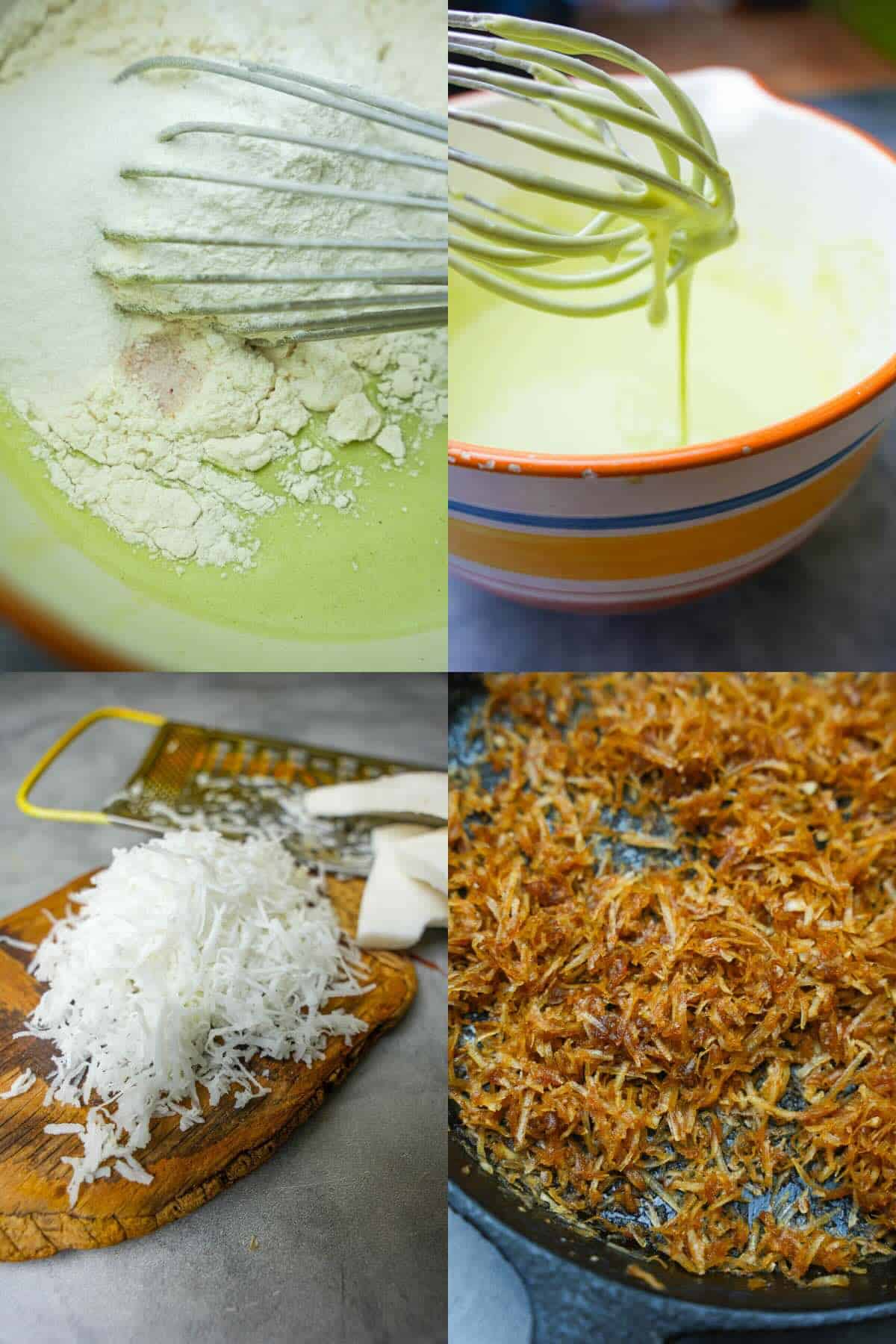
Step 5
Once cooled, add the water, all-purpose flour, glutinous rice flour, sugar, and salt.
Step 6
Whisk until well combined. Let the batter sit for 5 minutes to allow the flour to fully hydrate and the gluten to relax, resulting in a smoother texture.
Step 7
Meanwhile, grate the coconut. If you aren’t using fresh coconut meat, use unsweetened shredded dried coconut.
Step 8
In a frying pan, combine the freshly grated mature coconut meat, palm sugar, water, and vanilla extract. Cook the mixture over low heat, stirring constantly, until the palm sugar has melted and the coconut has absorbed the flavors, resulting in a moist and lightly browned caramelized filling. Remove from heat and let it cool.

Step 9
Heat a non-stick pan or skillet over medium heat. Once hot, pour a ladleful of the crepe batter onto the pan, swirling it around to create a thin and even thin crepe. Approximately ½ of a cup of batter is needed for a 9-inch pan.
Step 10
Cook the crepe for about two to three minutes, until the edges start to curl up and the pancake is set. Flip it over and cook for an additional 30 seconds to 1 minute until it is just set but still soft to the touch. Repeat this process with the remaining batter.
Step 11
Repeat this process with the remaining batter.
Step 12
Place a spoonful of the prepared coconut filling along one side of each pancake. Carefully fold the sides over the filling and roll the pancake tightly like a neatly formed miniature burrito. Repeat this process for all the pancakes, creating a delightful collection of Kuih Dadar rolls.
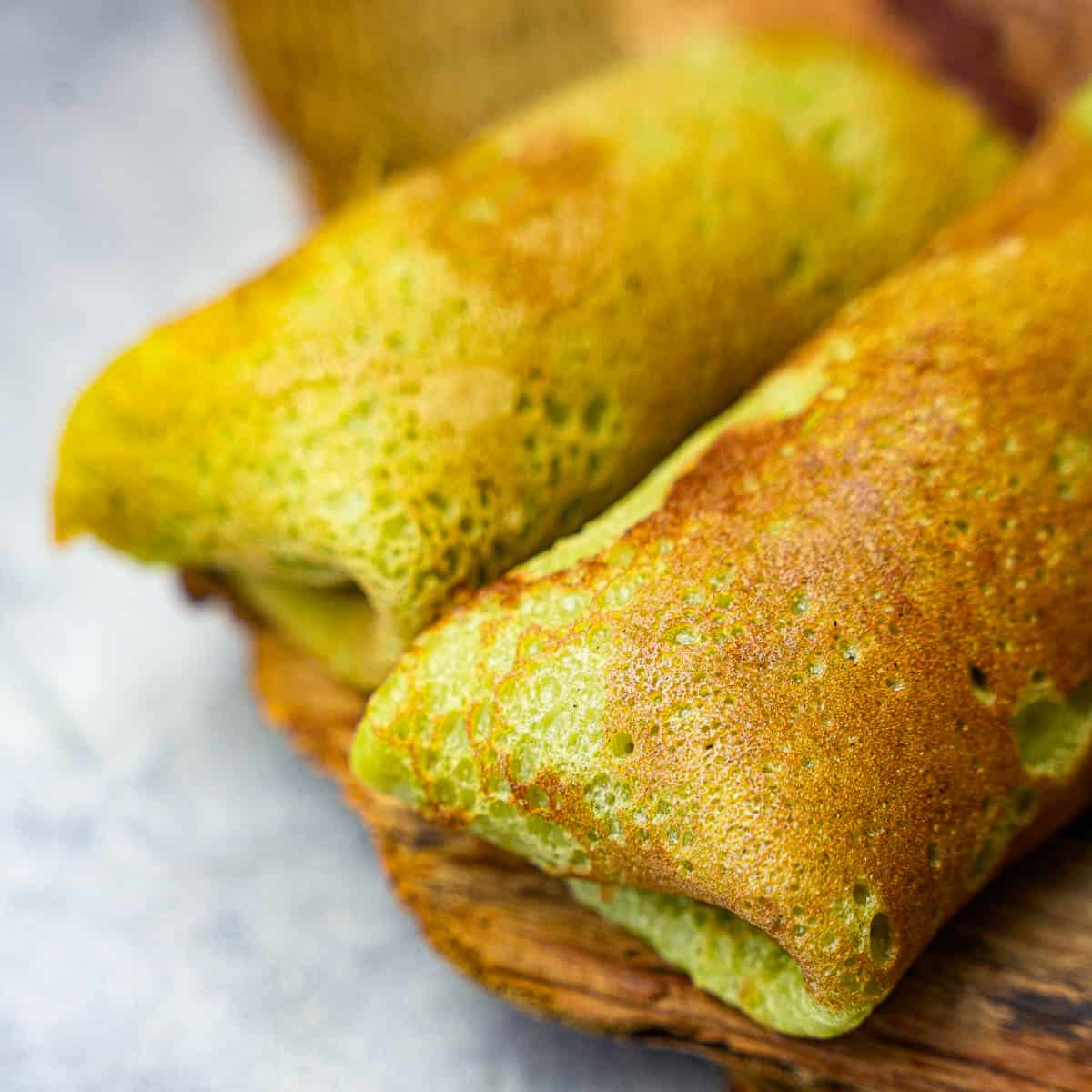
Step 13
Serve the Kuih Dadar seam side down for an attractive presentation.
🍽️Serving Ideas
Here’s some bangin’ meals you could serve Kuih Ketayap as a dessert after:
Serve Kuih Dadar after a fragrant bowl of tahu goreng, or Sayur Lodeh, a flavorful Indonesian vegetable curry that goes awesome on nasi minyak.
Ketoprak is an Indonesian salad dish featuring rice vermicelli, and bean sprouts, tofu, all tossed in a rich peanut sauce. Or make these green lil' goodies after a bowl of mee rebus, or Vietnamese rice paper salad, why dontcha?
Stir-fried noodle dishes like Mi Xao Xi Dau, Burmese curry noodles, or for a Thai-inspired pairing, serve Kuih Dadar after Pad Woon Sen, a flavorful glass noodle dish. Curried Spinach and Potatoes or Tofu Katsu on top? Why freaking not?

✅ Top Tips
- Rest the Batter: Allow the batter to rest for 5 minutes after combining the flours, coconut milk, and salt. This step ensures the flour is fully hydrated, resulting in a smoother and more cohesive batter.
- Thin and Even Pancakes: Aim for thin and evenly cooked pancakes. Use a ladle to pour the batter onto the pan, then quickly swirl it around to spread it evenly. This creates a delicate texture and ensures even cooking.
- Gentle Filling: When placing the coconut filling on the pancakes, avoid overstuffing. A modest amount ensures the pancakes can be rolled tightly without tearing.
🤷♀️ Recipe FAQs
Room Temperature: Kuih Dadar is best stored at room temperature in an airtight container or covered with plastic wrap. Avoid refrigerating the rolls, as it can cause them to become dry and lose their texture.
Consume within two days: Kuih Dadar is most delicious when enjoyed fresh. But if you can’t eat them all when you make them, consume the rolls within 36 hours of preparation to savor their optimal taste and texture.
Avoid Reheating: It is not recommended to reheat the rolls, as they can become dry and lose their delicate texture. Instead, enjoy them as is, allowing their flavors to shine at room temperature.
Glutinous rice flour is essential for achieving the desired chewy texture in Kuih Dadar. Using regular rice flour will tragically alter the texture and consistency.
Palm sugar contributes to the unique flavor of Kuih Dadar, but you can substitute with coconut sugar or dark brown sugar for a similar depth of flavor.
✌️Some of my favey other vegan desserts:
Say Hi on Social! 👋
Follow me on Instagram & Facebook for more recipes.
❤️Love this recipe? It helps me out greatly if you leave a 5-star 🌟🌟🌟🌟🌟rating in the recipe card below and maybe even leave me a lovey-dovey comment too!
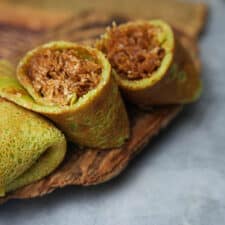
Kuih Dadar | Kuih Ketayap (Malaysian pandan coconut crepes)
Equipment
Ingredients
Crepes
- 13.5 oz. coconut milk
- 5 pandan leaves or ⅓ cup frozen ground pandan leaf
- ¼ cup water
- 1 cup all-purpose flour
- 2 tablespoons glutinous rice flour
- 3 tablespoons sugar
- ¼ teaspoon salt
Filling
- 1 ¼ cups freshly grated mature coconut meat
- ⅓ cup palm sugar gula melaka, or coconut sugar
- ¼ cup water
- ½ teaspoon vanilla extract
Instructions
- Knot and bruise the pandan leaves. In a saucepan, combine the coconut milk and pandan. Gently heat the mixture over medium heat until it is warm, but not boiling.
- Place the contents of the pot into a blender, and puree for 30 seconds on medium speed.
- Pour the contents of the blender through a fine mesh strainer or cheese cloth into a bowl to remove the bits of pandan, and press the pulp to get all of the pandan juice and coconut milk out.
- When the liquid is cool, whisk in the water, all-purpose flour, glutinous rice flour, sugar, and salt. Allow the batter to sit for 5 minutes before using it so that the flour in the batter becomes fully hydrated and the gluten relaxes a little.
- Meanwhile, in a small saucepan, combine the freshly grated mature coconut meat, palm sugar, water, and vanilla extract. Cook the mixture over low heat, stirring constantly, until the palm sugar has melted and the coconut has absorbed the flavors, resulting in a moist and lightly browned caramelized filling. Remove from heat and let it cool.
- Heat a non-stick pan or skillet over medium heat. Once hot, pour a ladleful of the pancake batter onto the pan, swirling it around to create a thin and even pancake. This will use about ⅓ of a cup of batter if you using a 9-inch pan. Cook for approximately two-three minutes until the edges start to curl up and the pancake is set. Flip it over and cook for an additional 30 seconds to 1 minute until just set but still soft to the touch. Repeat this process with the remaining batter.
- Place a spoonful of the prepared coconut filling along one side of each pancake. Fold the sides over the filling and roll the pancake tightly to form a neat cylinder. Repeat this process for all the pancakes.
- Serve the Kuih Dadar rolls on an attractive plate, seam side down.
Notes
- Use a fine mesh strainer or cheesecloth to achieve a smooth coconut milk mixture by filtering out any remaining bits of pandan leaves.
- If you can't get fresh coconut meat, use unsweetened, dried, shredded coconut.
- Allowing the batter to rest for 5 minutes ensures proper hydration of the flours and results in a better texture for the pancakes.
- Adjust the cooking time of each pancake based on the size of the pan and the desired texture, ensuring they are cooked through but still soft and pliable.
- To achieve neat and compact rolls, place the filling along one side of the pancake and roll tightly, applying gentle pressure as you go.


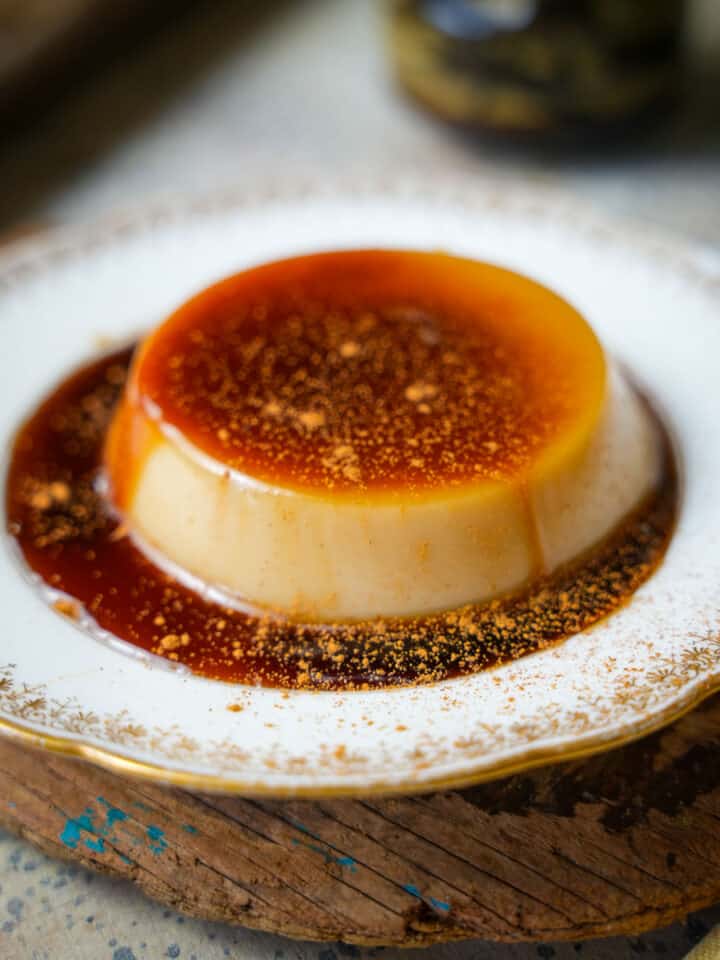
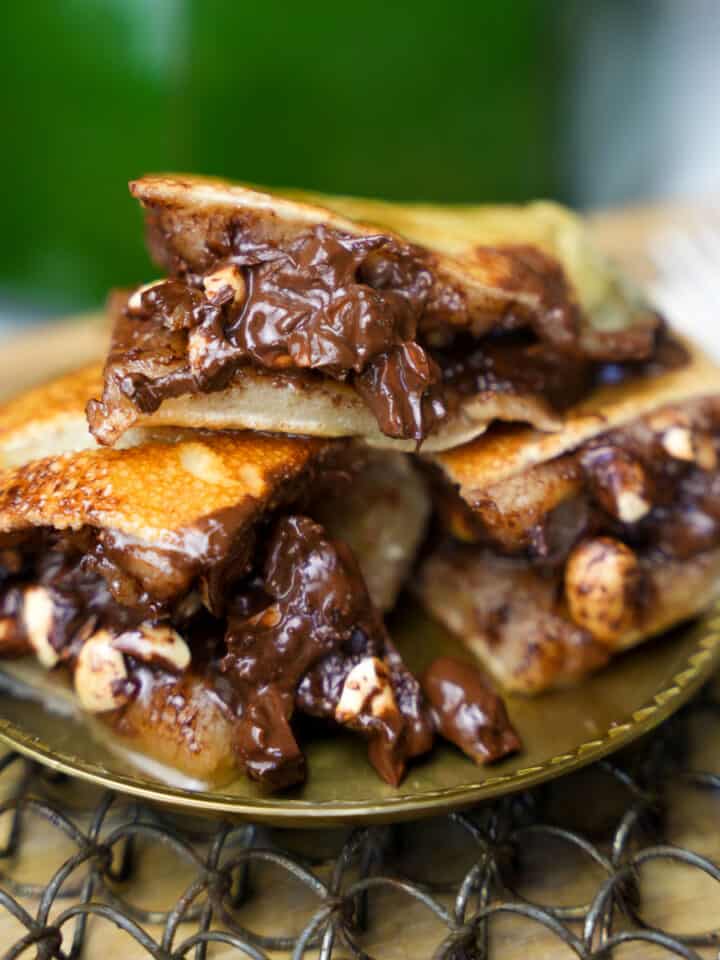
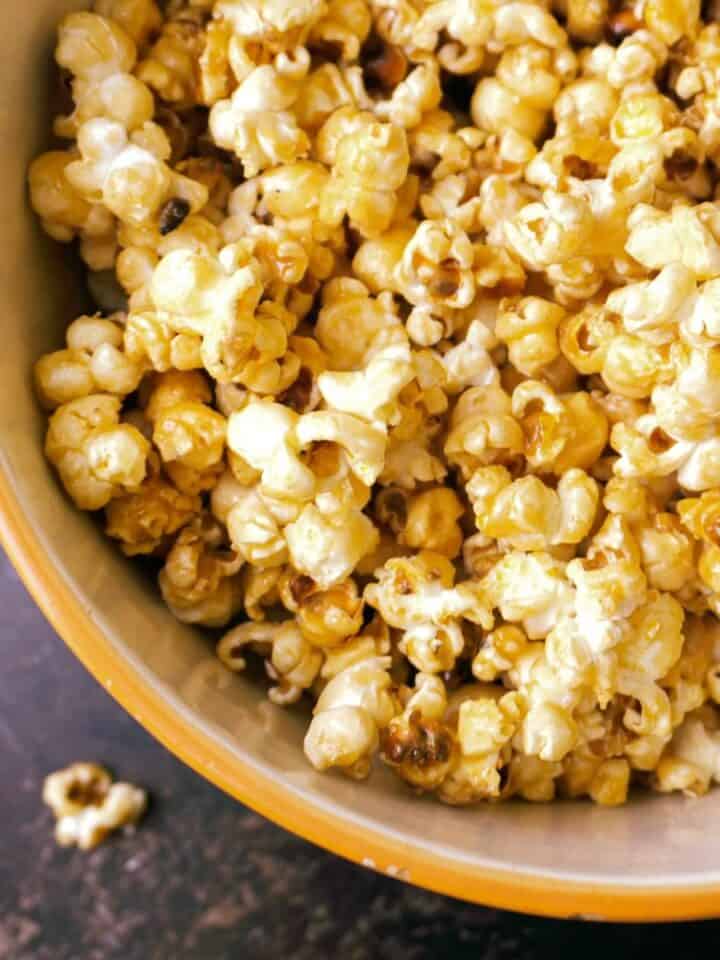
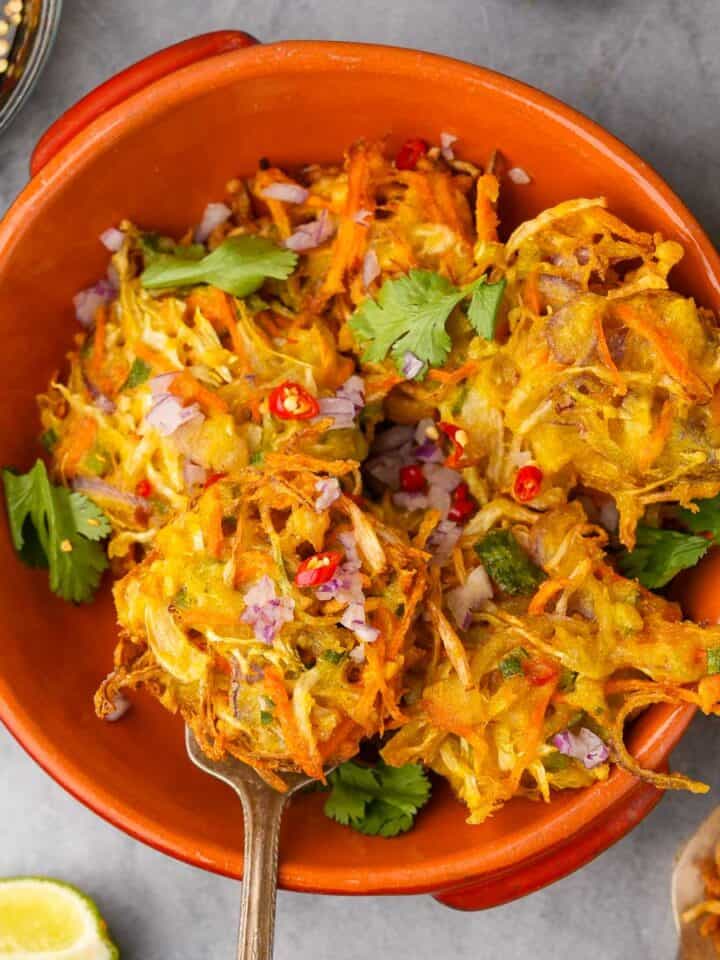
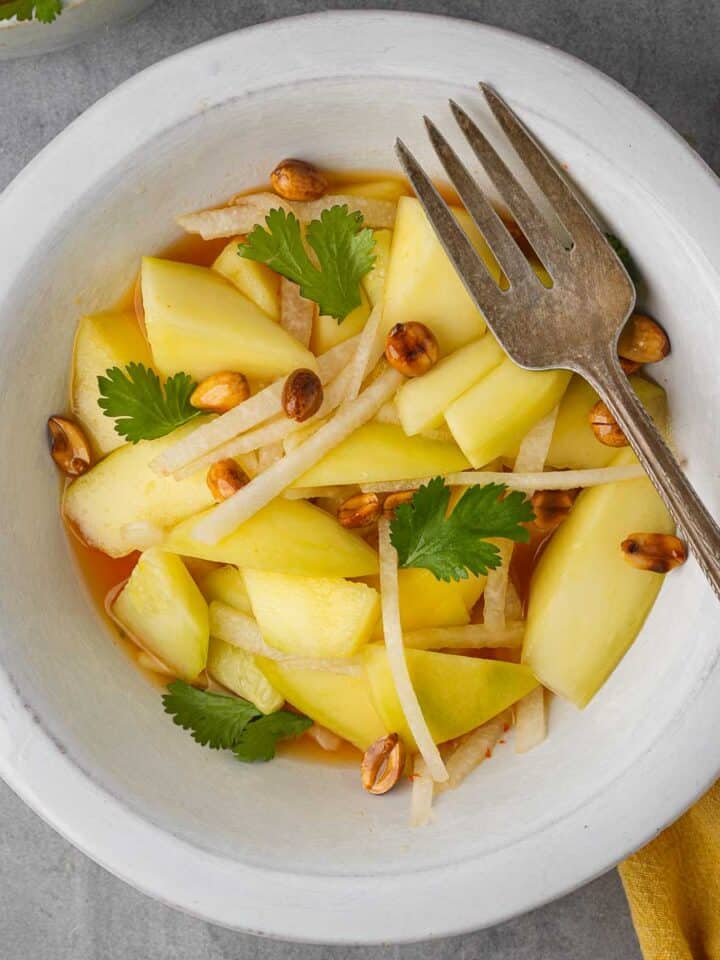
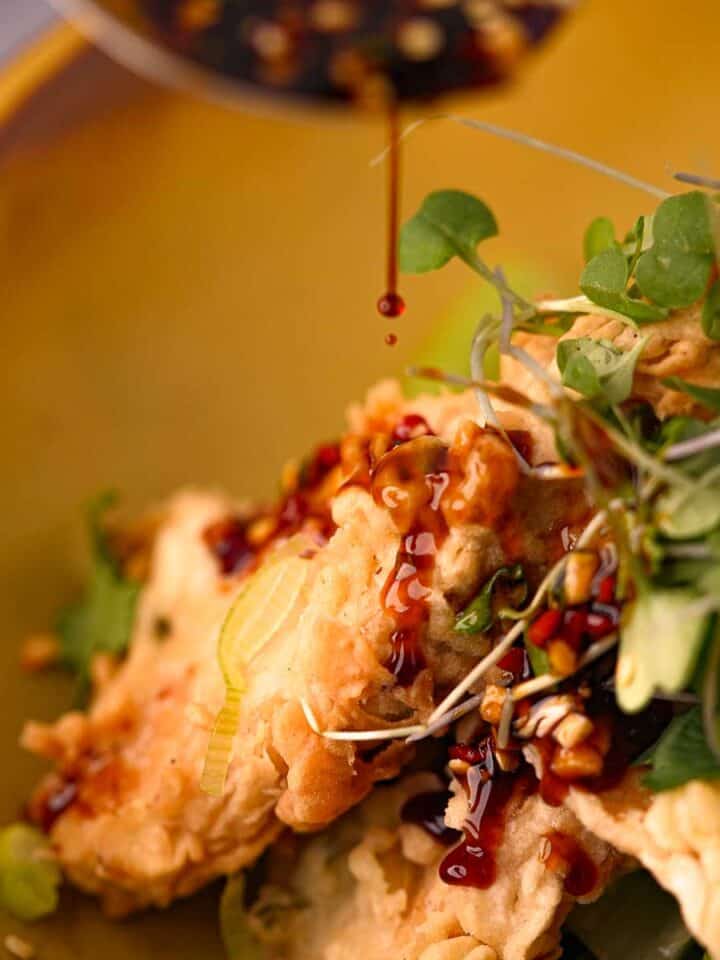
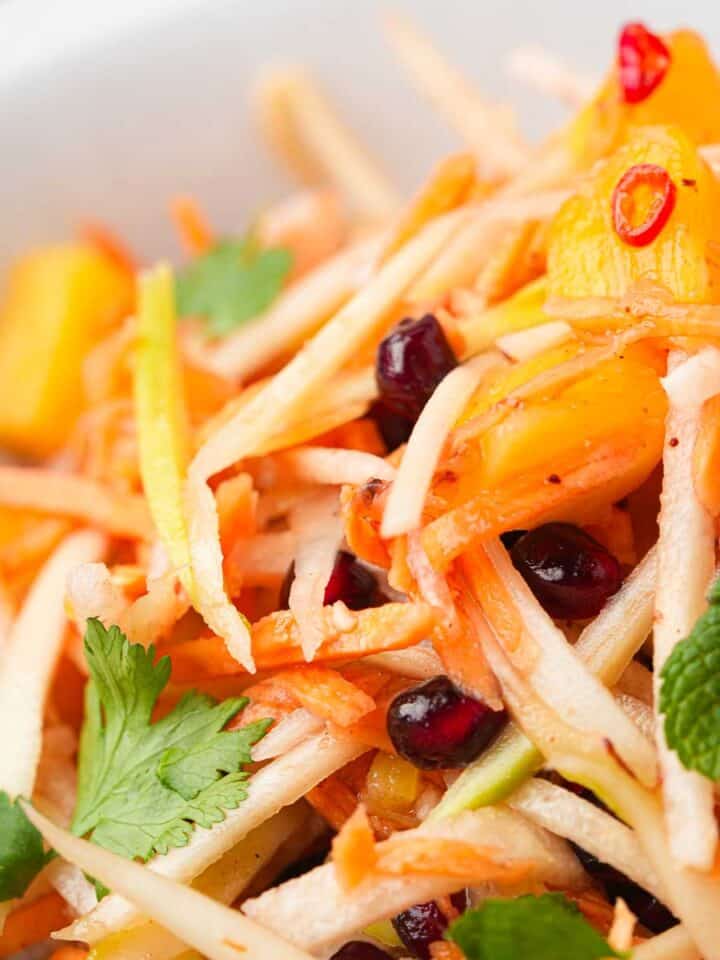

Leave a Reply